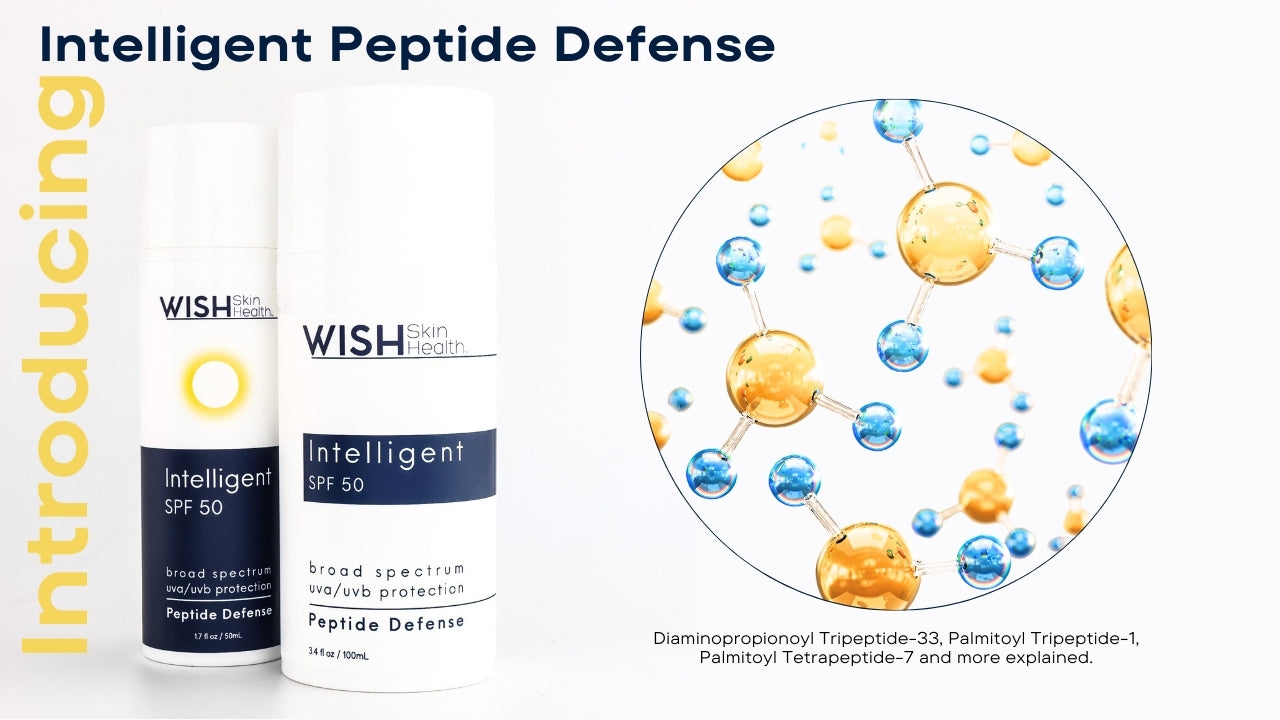Clearly Intelligent Protection

NEW: Intelligent™ SPF 50
Facial skin requires extra care and attention, especially when it comes to sun protection. Intelligent SPF 50 is designed to not only protect the skin from harmful UV rays but also provide nourishing and soothing benefits. This blog will explore the active and inactive ingredients in this formula and discuss their specific benefits.
Active Ingredients: Intelligent SPF 50 contains four organic filters: Avobenzone, Homosalate, Octisalate, and Octocrylene. Avobenzone, a broad-spectrum UV filter, provides protection against UVA rays, which are responsible for long-term skin damage and aging (Gasparro, 2000). Homosalate absorbs UVB rays and prevents sunburn, while Octisalate enhances UVB protection and offers water resistance (Kirkland & Mottus, 2022). Octocrylene stabilizes other UV filters, ensuring they remain effective throughout the day (Wang, 2018).
Intelligent SPF 50 offers various benefits that make it suitable for most skin types.
- C12-15 Alkyl Benzoate: Softens and smoothes the skin, providing a non-greasy feel (Ananthapadmanabhan, 2012).
- Glycerin (Vegetable Derived): Attracts moisture to the skin, keeping it hydrated and preventing dryness (Proksch, 2008).
- Caprylic/Capric Triglyceride (Coconut): Moisturizes the skin and improves its barrier function without clogging pores (Kochhar & Henry, 2009).
- Butylene Glycol: Attracts moisture and improves skin texture (Robinson, 2015).
- Diaminopropionoyl Tripeptide-33: A novel peptide known for its significant photo-protective properties. It works at a molecular level to prevent and repair damage caused by UV radiation, a major factor in accelerated skin aging. By inhibiting the formation of reactive carbon species and carbonylated proteins, it protects skin cells from DNA damage and enhances the DNA repair system. Overall, Diaminopropionoyl Tripeptide-33 helps to maintain a healthier, more youthful-looking appearance by combating both intrinsic and extrinsic aging factors. (Peral, 2013) UVA and UVB cause different biological effects on the skin. UVA radiation penetrates the epidermis resulting in damage to the dermis. Furthermore, UVA is mainly responsible for indirect DNA damage. UVB is mostly absorbed in the epidermis and its main mechanism of action is the direct interaction with DNA via induction of DNA damage. In the aging process, the various DNA repair systems decrease their ability, as a result of the accumulation of mutagenic DNA photoproducts.Reactive carbonyl species (RCS) are potent mediators of cellular carbonyl stress originating from chemical processes. Trans-4-hydroxy-2-nonenal (4-HNE) is one of the most abundant and cytotoxic of the RCS. HNE reacts with a variety of nucleophilic sites in DNA and proteins, generating various types of adducts. Intracellular RCS are suggested to play an important role in oxidative stress through their inhibitory effect on DNA repair mechanisms as well as on induction of DNA damage through its direct interaction with repair proteins.
- Lactobacillus/Oat Ferment Extract Filtrate and Colloidal Oatmeal Extract: Soothe and calm irritated skin, reducing redness and inflammation (Wisniewski, 2013).
- Calendula Officinalis Extract and Recutita (Matricaria) Extract: Provide anti-inflammatory benefits and soothe sensitive skin (Preethi 2009; Srivastava, 2010).
- Aloe Vera Leaf Extract: Moisturizes and offers healing attributes to the skin (Surjushe, 2008).
- Cetyl Alcohol and Stearyl Alcohol: Hydrate while Improving the texture of the formula, making it easy to apply.
- Camellia Sinensis (Green Tea) Leaf Extract: Protects the skin from free radical damage and soothes irritation (Katiyar, 2003).
- Allantoin: Supports healing and softens the skin (Shanbhag, 2019).
- Panax Ginseng Root Extract: Provides healthy-aging benefits and improves skin vitality (Tae-Wook, 2017).
- Palmitoyl Tripeptide-1 and Palmitoyl Tetrapeptide-7: Improve skin elasticity and firmness (Ramos-e-Silva, 2013). Tripeptide-1 and Palmitoyl Tetrapeptide-7 are synthetic peptides that have been shown to significantly improve skin elasticity and firmness. These peptides work by stimulating collagen production and promoting healthy cell function. Collagen is a key protein in the skin that provides structure and elasticity, so increasing its production can lead to firmer, more youthful-looking skin. What makes these peptides revolutionary is their ability to offer healthy-aging benefits without causing irritation or breakouts. Many sunscreens for acne-prone skin can be irritating or contain comedogenic (pore-clogging) ingredients that can exacerbate acne. However, these peptides are non-comedogenic and gentle on the skin, making them an excellent addition. Intelligent SPF 50 is a fantastic option for anyone looking to maintain healthy, youthful skin while also protecting it from harmful UV damage.
- Zinc PCA: Maintains the skin's natural moisture balance and helps control acne (Pathak, 2012).
- Punica Granatum (Pomegranate) Seed Oil and Citrullus Lanatus (Watermelon) Seed Oil: Hydrate and provide additional healthy aging benefits (Lansky, 2005; Brown, 2005).
- Panthenol (Vitamin B5) and Tocopheryl (Vitamin E): Improve skin hydration and health (Ebner, 2002).
Intelligent™ SPF 50 offers comprehensive protection and skincare benefits, making it an excellent choice for those with sensitive and acne-prone skin. Its carefully selected ingredients ensure that the skin stays protected, hydrated, and healthy. The non-greasy formula, combined with moisturizing, soothing, and antioxidant ingredients, makes this formula a must-have for anyone looking to maintain healthy and protected skin.
Age Intelligently™
References

